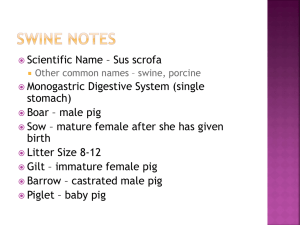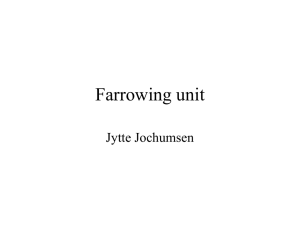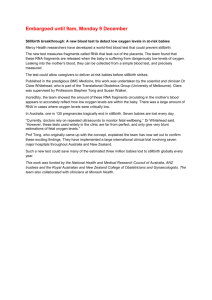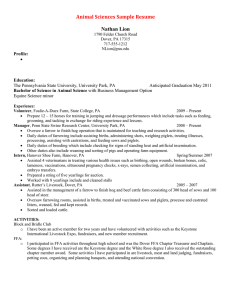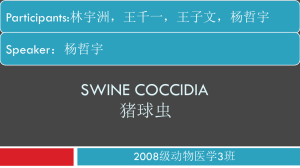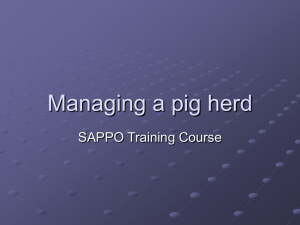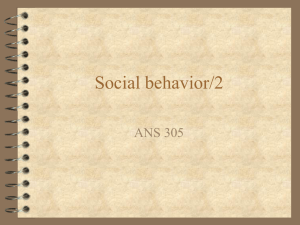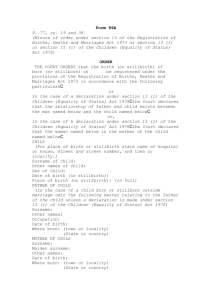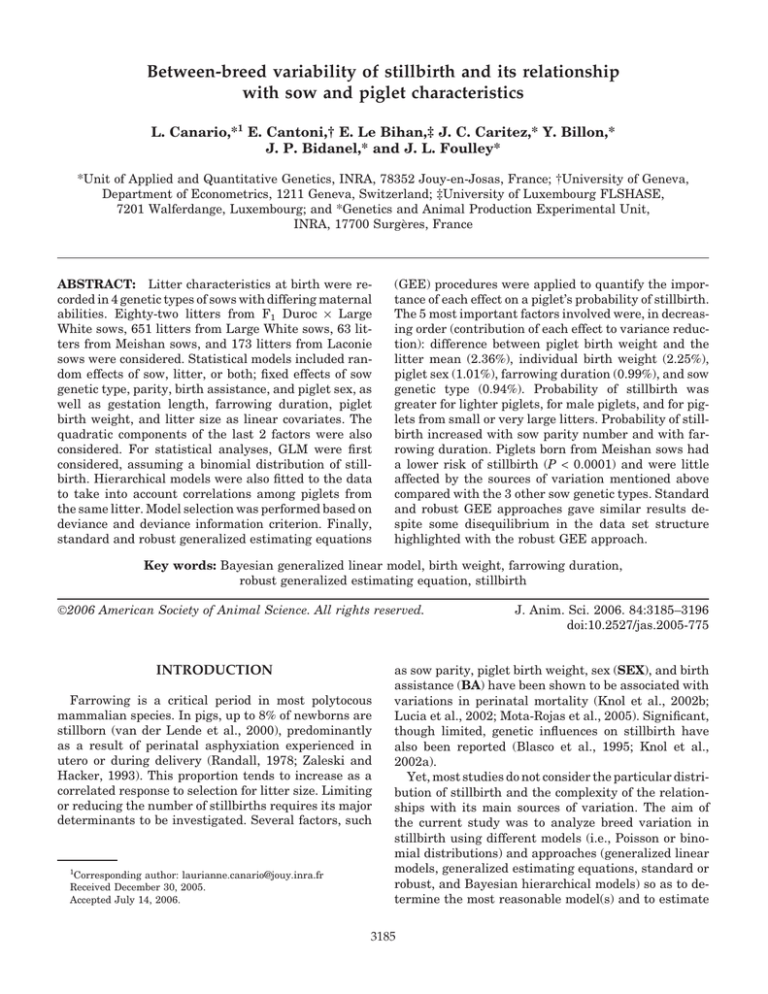
Between-breed variability of stillbirth and its relationship
with sow and piglet characteristics
L. Canario,*1 E. Cantoni,† E. Le Bihan,‡ J. C. Caritez,* Y. Billon,*
J. P. Bidanel,* and J. L. Foulley*
*Unit of Applied and Quantitative Genetics, INRA, 78352 Jouy-en-Josas, France; †University of Geneva,
Department of Econometrics, 1211 Geneva, Switzerland; ‡University of Luxembourg FLSHASE,
7201 Walferdange, Luxembourg; and *Genetics and Animal Production Experimental Unit,
INRA, 17700 Surgères, France
ABSTRACT: Litter characteristics at birth were recorded in 4 genetic types of sows with differing maternal
abilities. Eighty-two litters from F1 Duroc × Large
White sows, 651 litters from Large White sows, 63 litters from Meishan sows, and 173 litters from Laconie
sows were considered. Statistical models included random effects of sow, litter, or both; fixed effects of sow
genetic type, parity, birth assistance, and piglet sex, as
well as gestation length, farrowing duration, piglet
birth weight, and litter size as linear covariates. The
quadratic components of the last 2 factors were also
considered. For statistical analyses, GLM were first
considered, assuming a binomial distribution of stillbirth. Hierarchical models were also fitted to the data
to take into account correlations among piglets from
the same litter. Model selection was performed based on
deviance and deviance information criterion. Finally,
standard and robust generalized estimating equations
(GEE) procedures were applied to quantify the importance of each effect on a piglet’s probability of stillbirth.
The 5 most important factors involved were, in decreasing order (contribution of each effect to variance reduction): difference between piglet birth weight and the
litter mean (2.36%), individual birth weight (2.25%),
piglet sex (1.01%), farrowing duration (0.99%), and sow
genetic type (0.94%). Probability of stillbirth was
greater for lighter piglets, for male piglets, and for piglets from small or very large litters. Probability of stillbirth increased with sow parity number and with farrowing duration. Piglets born from Meishan sows had
a lower risk of stillbirth (P < 0.0001) and were little
affected by the sources of variation mentioned above
compared with the 3 other sow genetic types. Standard
and robust GEE approaches gave similar results despite some disequilibrium in the data set structure
highlighted with the robust GEE approach.
Key words: Bayesian generalized linear model, birth weight, farrowing duration,
robust generalized estimating equation, stillbirth
©2006 American Society of Animal Science. All rights reserved.
INTRODUCTION
Farrowing is a critical period in most polytocous
mammalian species. In pigs, up to 8% of newborns are
stillborn (van der Lende et al., 2000), predominantly
as a result of perinatal asphyxiation experienced in
utero or during delivery (Randall, 1978; Zaleski and
Hacker, 1993). This proportion tends to increase as a
correlated response to selection for litter size. Limiting
or reducing the number of stillbirths requires its major
determinants to be investigated. Several factors, such
1
Corresponding author: laurianne.canario@jouy.inra.fr
Received December 30, 2005.
Accepted July 14, 2006.
J. Anim. Sci. 2006. 84:3185–3196
doi:10.2527/jas.2005-775
as sow parity, piglet birth weight, sex (SEX), and birth
assistance (BA) have been shown to be associated with
variations in perinatal mortality (Knol et al., 2002b;
Lucia et al., 2002; Mota-Rojas et al., 2005). Significant,
though limited, genetic influences on stillbirth have
also been reported (Blasco et al., 1995; Knol et al.,
2002a).
Yet, most studies do not consider the particular distribution of stillbirth and the complexity of the relationships with its main sources of variation. The aim of
the current study was to analyze breed variation in
stillbirth using different models (i.e., Poisson or binomial distributions) and approaches (generalized linear
models, generalized estimating equations, standard or
robust, and Bayesian hierarchical models) so as to determine the most reasonable model(s) and to estimate
3185
3186
Canario et al.
the combined effects of several potentially important
sources of variation.
MATERIALS AND METHODS
Animals and Data Recording
Animal care followed the general guidelines outlined
in the European animal welfare regulations. Litter
characteristics at birth (i.e., farrowing kinetics and the
number and weight of piglets born alive or dead) were
recorded in 969 litters farrowed by 511 sows of 4 genetic
types (GT): Large White (LW, 651 litters), Meishan
(MS, 63 litters), Laconie male line (LA, 173 litters—a
synthetic line based on Hampshire, Pietrain, and LW
breeds), and F1 Duroc × Large White (DU × LW, 82
litters). The data were collected in the INRA experimental herd of Le Magneraud (Charente-Maritime) from
1999 to 2003.
Sows were managed under a batch farrowing system,
with 3-wk intervals between successive batches. They
entered the farrowing unit 1 wk before the expected
date of parturition. There, they were housed in individual crates with slatted floors until weaning. Farrowing
was induced with prostaglandin (Planate-doprostenol
Schering-Plough Animal Health, Uxbridge, UK) on d
113 of gestation. The need for birth assistance resulted
from specific indications (e.g., a lengthy interval between successive births, a lack of contractions, or both).
Assistance consisted of oxytocin injections and vaginal
palpation during farrowing, which accounted for 6.4
and 3.0% of parturitions, respectively. Piglet births
were observed every 15 min. Farrowing duration was
defined as the interval of time elapsed between the
birth of the first and last piglet of the litter. Newborn
piglets were individually weighed and sexed within 24
h after farrowing. The farrowing duration effect was
estimated on a subset of 614 records, including 28 MS,
445 LW, 99 LA, and 42 DU × LW litters.
Statistical Analyses
A large number of potential sources of variation in
stillbirth were investigated: sow GT, parity, BA, and
SEX as fixed effects; gestation length (GEST), total
number born (TNB), litter birth weight, and farrowing
duration (FD) as covariates; and piglets’ dam, birth
litter, or both as random effects. The effect of birth
weight was investigated using the raw value (individual
birth weight = IBW) or the difference (DBW) from the
within-litter mean birth weight (MBW). Birth assistance was considered as a binary trait (0 = no assistance; 1 = 1 or several assistances). Parity included 5
categories: 1, 2, 3, 4, and ≥5.
Statistical analyses were carried out assuming 2 different distributions for stillbirth: a binomial or a Poisson (with offset) distribution. Three approaches were
used successively: GLM, Bayesian hierarchical models,
and generalized estimating equations (GEE). The first
modeling approach assumed independent data,
whereas the last 2 took into account correlations among
piglets within-litter. Moreover, in the case of GEE, a
robust analysis (Cantoni, 2004) was considered in addition to the standard procedure (Liang and Zeger, 1986;
Zeger and Liang, 1986) so as to investigate the incidence
of outliers in the data set.
The GLM (McCullagh and Nelder, 1983) analyses
were applied to litter grouped data (Collett, 2003) using
the GENMOD procedure (SAS Inst. Inc., Cary, NC).
Analyses assuming a Poisson or a binomial distribution
of stillbirth (using both logit and probit link functions)
were performed. All fixed effects and their first order
interactions were considered; explanatory variables
were then selected using a backwise procedure according to their deviance from the complete model (significance level lower than 5%). In case of overdispersion,
effects were tested using an adjusted deviance (i.e., the
deviance divided by the dispersion parameter φ = D0/
[N − p0], where D0 and p0 are, respectively, the deviance
and number of parameters from the full model). The
adequacy of the complete and full models and the comparison of nested models were tested via F-statistics
(Collett, 2003).
The GLM runs can be viewed as preliminary analyses
aimed at selecting sets of meaningful explanatory variables and determining their mode of action (additivity
or interactions, or both) before the final statistical analysis. Then, the data were analyzed using a random
logistic regression in a Bayesian hierarchical framework via the Winbugs software (Spiegelhalter et al.,
2003). Model selection was performed based on deviance and deviance information criterion (DIC). Assuming for example, a binomial distribution of Yi, where Yi
is the number of dead piglets in the ith litter of size ni
with probability of stillbirth πi, the hierarchical model
involved the following 2 steps of sampling:
i) Yi | πi ∼id B(ni, πi), and
ii) logit(πi) ∼id N(ηi, σ2),
where ηi = β0 + β1x1i + ... + βkxki corresponded to the joint
effect of explanatory variables x1i,...,xki with regression
coefficients β0, β1,...,βk on litter i, and where σ2 was the
variance between litters in the probability of stillbirth
on the logit scale. Note that ii) can be alternatively
written as logit(πi) = ηi + σzi, where zi ∼id N(0,1) is the
standardized random effect of litter i. Noninformative
priors were assigned to β0, β1,...,βk using normal distributions with very large variances and to σ2 via 1/σ2 ∼
Γ(ε,ε) being a gamma distribution with a very small
value of ε = 10−5.
Classical GEE analyses were performed with the
GENMOD procedure of SAS software; this procedure
allowed the contribution of each fixed effect and each
covariate to the variance reduction to be evaluated using a stepwise procedure and tested with the coefficient
of determination of Hosmer and Lemeshow (1989). Ad-
3187
Stillbirth in pigs
Table 1. Estimates1 of dam genetic type effects (SE)
Dam GT
Trait2
TNB, No.
NBA, No.
NSB, No.
PSB, %
GEST, d
FD, h
LBW, kg
MBW, kg
BA,5 %
Test3
b
d
b
b
b
NS
b
c
—
Meishan
4a
13.3 (0.6)
12.0 (0.6)c
0.3 (0.1)c
3.0 (1.3)c
113.3 (0.12)c
2.7
17.3 (0.9)
1.32 (0.05)d
4.8
Large White
Duroc ×
Large White
Laconie
12.2 (0.2)
10.6 (0.2)
0.7 (0.1)
6.5 (0.5)
113.7 (0.04)
2.9
17.4 (0.7)
1.51 (0.04)
9.7
12.8 (0.6)
11.6 (0.6)a
0.6 (0.1)
4.8 (1.2)
113.6 (0.12)
2.9
18.9 (1.4)
1.54 (0.08)
25.6
11.3 (0.4)b
9.6 (0.4)b
0.7 (0.1)
6.8 (0.9)
113.6 (0.08)
2.7
15.3 (0.8)c
1.53 (0.04)
9.8
Not significant; aP < 0.10; bP < 0.05; cP < 0.01; dP < 0.001.
Estimates from a mixed model including genetic type, parity, and farrowing batch as fixed effects, and
sow as random effect. Estimates were obtained using REML methodology (Patterson and Thompson, 1971)
with the MIXED procedure of SAS (SAS Inst. Inc., Cary, NC).
2
Total number born (TNB); number born alive (NBA); number (NSB) and proportion (PSB) of stillborn
piglets per litter; birth assistance (BA); gestation length (GEST); farrowing duration (FD); litter birth weight
(LBW); and mean birth weight (MBW).
3
Level of significance of breed effect test using Wald score statistics.
4
Level of significance of the test of the contrast to Large White breed.
5
No statistical comparison was performed for BA.
NS
1
ditionally, interactions between GT and covariates (i.e.,
GEST, TNB, FD, IBW, DBW, and MBW) were included
to test the homogeneity of covariate functions between
GT. The within-subject correlation coefficient, associated with the implementation of an exchangeable matrix on the random effect, was tested using the GEEse
procedure from the R software (Yan and Højsgaard,
2006).
The classical GEE estimator for both regression and
nuisance parameters can be highly influenced by deviating data points (outliers). A robust version of GEE
(Cantoni, 2004) was hence used with the S-PLUS software (Insightful Corp., 2004) with routines available
from E. Cantoni (http://www.unige.ch/ses/metri/cantoni/). Robust statistics (Hampel et al., 1986) consider
that models are only ideal approximations and that in
practice their assumptions are almost never fully met.
Therefore, estimators and test statistics that are stable
in a neighborhood of the postulated model are developed. The robust GEE procedure is one of these tools
and can be seen as a weighted version of the standard
GEE equations, with 2 types of weights, one to control
for deviations on the response space on one side and
another to control for deviations on the design space
on the other side. Inspection of these weights from a
fitted robust GEE model allows departing observations
(i.e., those that have been given small weights) to be
identified.
A robust binary GEE model including GT, parity, and
BA as fixed effects was fitted and compared with a
standard GEE. A characterization of the subpopulation
of down-weighted observations from this model was carried out using the GLM procedure of SAS. This analysis
allowed suspected separation in the data to be identified. Given that complete separation would imply the
nonexistence of the estimator, the methodology of
Christmann and Rousseeuw (2001) was used (package
ncomplete from R software, A. Christmann, http://
www.statistik.uni-dortmund.de/de/textonly/content/
einrichtungen/lehrstuehle/personen/christmann/soft
ware.html) to compute the overlap (i.e., the smallest
number of observations whose removal yielded complete separation).
RESULTS
Model Selection
Genetic type estimations are presented in Table 1.
The performance of LW, DU × LW, and LA sows did
not differ for any of the traits investigated. Conversely,
MS sows had a significantly larger litter size, smaller
number and proportion of stillbirth, shorter farrowing
duration, and lower mean birth weight than the 3
other GT.
Results of the GLM analyses are shown in Table 2.
Covariates selected were the same whatever the distribution (binomial or Poisson) and link function (probit
or logit) hypothesized. Because no difference appeared
between these 2 link functions, we chose the most common one (i.e., the logit) for the remaining analyses. The
full model was rejected unless a correction for overdispersion was applied. All main effects related to the
sow (i.e., GT, parity, and BA) were selected, but no
interaction reached statistical significance.
Results from the Bayesian analyses are given in Table 3. They clearly showed the superiority of models
assuming a binomial distribution over those assuming
a Poisson distribution (differences in DIC values exceeded 10). Results additionally indicated that the
model with litter as a single random effect was satisfactory to take into account correlations among piglets
3188
Canario et al.
Table 2. Model selection for stillbirth based on standard GLM analyses1
Binomial model
Model expression2
Nested model
Without correction for data dispersion
(−1) = Saturated model
(0) = Full model
+ GT + P + BA + GT × P
+ GT × BA + P × BA
(1) = (0) − P × BA
+ GT + P + BA + GT × P
+ GT × BA
(2) = (1) − GT × BA
+ GT + P + BA + GT × P
(3) = (2) − GT × P
+ GT + P + BA
(4) = (3) − BA
+ GT + P
(5) = (3) − P
+ GT + BA
(6) = (3) − GT
+ P + BA
NP3
df
Deviance
Deviance
difference
P-value
Deviance
Deviance
difference
P-value
969
28
941
0
1,207.1
1,207.1
<0.0001
0
1,232.1
1,232.1
<0.0001
24
4
1,210.6
3.5
0.48
1,236.3
4.2
0.37
21
9
8
5
6
3
12
1
4
3
1,214.4
1,230.9
1,237.5
1,253.2
1,279.6
3.8
16.5
6.6
15.7
26.4
0.28
0.17
0.01
0.0001
<0.0001
1,241.4
1,256.9
1,269.7
1,276.8
1,314.1
5.0
15.6
12.8
7.1
37.3
0.17
0.21
0.0003
0.0005
<0.0001
With correction for data dispersion
(−1) = Saturated model
(0) = Full model
(1) = (0) − P × BA
(2)
(3)
(4)
(5)
(6)
=
=
=
=
=
(1)
(2)
(3)
(3)
(3)
−
−
−
−
−
GT × BA
GT × P
BA
P
GT
+ GT + P + BA + GT × P
+ GT × BA + P × BA
+ GT + P + BA + GT × P
+ GT × BA
+ GT + P + BA + GT × P
+ GT + P + BA
+ GT + P
+ GT + BA
+ P + BA
Poisson model
(φ = D0/[N − p0] = 1.283)4
⌬ deviance/φ P-value
0
1,207.1
733.4
0.99
(φ = D0/[N − p0] = 1.309)
0
1,232.1
941.2
0.49
969
28
941
24
4
1,210.6
2.7
0.60
1,236.3
3.2
0.52
21
9
8
5
6
3
12
1
4
3
1,214.4
1,230.9
1,237.5
1,253.2
1,279.6
3.0
12.9
5.1
12.2
20.6
0.40
0.38
0.02
0.002
<0.0001
1,241.4
1,256.9
1,269.7
1,276.8
1,314.1
3.9
11.8
9.8
5.4
28.5
0.28
0.46
0.002
0.004
<0.0001
1
Results obtained with a logit link function.
GT = Sow genetic type; P = parity; BA = birth assistance.
3
NP = Number of parameters.
4
φ = Dispersion parameter.
2
(1,882 vs. 1,884 DIC for litter + mother model and litter
model, respectively).
Results from classical GEE analyses (Table 4) were in
agreement with Bayesian analyses; a greater betweensubject correlation coefficient (α) was obtained from the
model including the litter as random effect in comparison to a sow random effect (α = 0.042 vs. 0.021). Both
coefficients were highly significant (P < 0.0001).
Sources of Variation for Stillbirth
Substituting dam GT with piglet GT gave very similar results (difference of deviance: 4,498.81 − 4,490.56 =
8.25 for 11 − 4 = 7 df; P = 0.311). No difference in
probability of stillbirth between purebred and crossbred
piglets was observed (P = 0.473).
The reduction in residual sum of squares due to the
successive addition of each explanatory variable demonstrated that birth weight (per se as IBW or as a
Table 3. Model comparison for stillbirth based on deviance information criterion (DIC)
Model
Model
Model
Model
1
2
3
4
Distribution
Random effect(s)
DIC
Binomial
Binomial
Binomial
Poisson
Litter + mother
Litter
—
Litter
1,881.7
1,884.2
2,028.6
1,931.8
difference DBW from the mean of the litter) was the
main determinant of piglet survival (+2.25 and +2.36%
in variance reduction, respectively), followed by SEX,
FD, sow GT, and parity (1.01, 0.99, 0.94, and 0.50%,
respectively) and the quadratic components of IBW
(0.30%) and DBW (0.23%; Table 5). The remaining effects made lower contributions (<0.21%).
Results from GEE analyses also demonstrated the
strong influences of GT, SEX, and DBW on probability
of stillbirth (P < 0.0001; Table 6). Genetic type × covariate interactions were not significant, except those involving birth weight (i.e., IBW and DBW). Piglets from
MS sows had a 86% lower probability of stillbirth than
piglets born from LW sows (P < 0.0001), whereas piglets
from DU × LW or LA sows had a similar probability as
those from LW sows. Probability of stillbirth did not
significantly differ from parity 1 to 4 but was 1.6 times
greater in the fifth (or later) parity (P < 0.05 to P <
0.001). A clearer view of parity × GT effects on probability of stillbirth is shown in Figure 1. Probability of
stillbirth decreased slightly from the first to the second
parity, and then progressively increased up to the fifth
parity, except for MS sows, where it remained at consistently low values.
Male piglets had an approximately 1.8 times greater
probability of stillbirth than female piglets (P < 0.0001;
Table 6). Piglets from litters with assistance during
parturition had a 1.4 times greater probability of stillbirth than litters without assistance (P = 0.03).
3189
Stillbirth in pigs
Table 4. Generalized estimating equations estimates (SE) assuming a binary distribution
and global test of sow vs. litter random effects on probability of piglet stillbirth
Model 1 (Sow effect)
Effect1
Intercept
GT DU × LW
GT MS
GT LA
Parity 2
Parity 3
Parity 4
Parity 5
GEST
BA
α
Global effect
(χ2)2
23.80e
12.87b
0.46NS
3.54a
Model 2 (Litter effect)
Level effect
(SE)3
1.00 (5.94)
−0.19 (0.19)
−1.71 (0.41)e
0.13 (0.15)
−0.25 (0.14)a
0.13 (0.16)
0.16 (0.17)
0.41 (0.17)b
−0.04 (0.05)
0.34 (0.16)b
0.021
Global effect
(χ2)2
43.25e
12.32b
0.894b
7.19c
Level effect
(SE)3
1.19 (5.99)
−0.14 (0.18)
−1.86 (0.41)e
0.10 (0.14)
−0.23 (0.15)
0.12 (0.17)
0.14 (0.17)
0.42 (0.17)b
−0.04 (0.05)
0.50 (0.15)c
0.042
1
Estimates were expressed as deviations from a piglet born from a Large White sow in first parity receiving
birth assistance. Genetic type (GT) of the sow with Duroc × Large White F1 (DU × LW), Meishan (MS),
and Laconie (LA); gestation length (GEST), birth assistance (BA); α: within-subject correlation coefficient.
2
Level of significance for χ2 statistic: NS = not significant; aP < 0.10 ; bP < 0.05 ; cP < 0.01; dP < 0.001;
e
P < 0.0001.
3
Figures correspond to the log odds ratio. Odds ratio can be obtained with an exponential transformation.
Level of significance for z statistic: same as in footnote 2.
Litter size had a nonlinear effect on probability of
stillbirth, except for litters from MS sows, where the
probability remained almost constant (Figure 2). In the
3 other GT, piglets from small and large litters were
more susceptible to die at farrowing with a minimum
probability for intermediate litters of 12 piglets. When
a global adjustment for IBW was made, the risk of
stillbirth increased in extreme litters, particularly in
small ones (Figure 2a vs. 2b).
Piglet birth weight affected probability of stillbirth
in an inverse exponential fashion (Figure 3) but with
a different magnitude in each GT, which resulted in a
significant GT × BW interaction. The increase in probability of stillbirth with decreasing birth weights was
highest in LW and lowest in MS litters. Differences in
probability of stillbirth were larger when the data were
adjusted for DBW instead of IBW (Figure 4 vs. Figure
3). The risk of stillbirth grew rapidly when piglet
Table 5. Reduction of deviance (GLM model)1 due to the addition of each explanatory
variable
Data set 13
Data set 23
Model2
Deviance
Reduction, %
Deviance
Reduction, %
(0) = intercept
(1) = (0) + GT
(2) = (1) + P
(3) = (2) + SEX
(4) = (3) + GEST
(5) = (4) + BA
(6) = (5) + TNB
(7) = (6) + TNB2
(8) = (7) + IBW
(9) = (8) + IBW2
(8) = (7) + MBW
(9) = (8) + MBW2
(10) = (9) + DBW
(11) = (10) + DBW2
(12) = (7) + FD
4,571.90
4,528.84
4,506.09
4,460.40
4,459.73
4,453.03
4,447.89
4,438.54
4,338.68
4,325.88
4,427.42
4,427.11
4,322.56
4,312.50
—
0.94
0.50
1.01
0.06
0.15
0.12
0.21
2.25
0.30
0.25
0.007
2.36
0.23
—
2,783.33
2,755.93
2,741.06
2,741.81
2,711.11
2,707.46
2,703.90
2,698.20
—
—
—
—
—
—
2,671.37
0.98
0.54
0.96
0.14
0.13
0.13
0.21
—
—
—
—
—
—
0.99
1
Modeling was realized with litter as subject for the correlation structure.
Sow genetic type (GT) with Duroc × Large White F1 (DU × LW), Meishan (MS), and Laconie (LA) sows;
parity (P), sex of the piglet (SEX), gestation length (GEST), birth assistance (BA), total number born (TNB),
individual birth weight (IBW), mean birth weight (MBW), difference from the within-litter mean birth
weight (DBW), and farrowing duration (FD).
3
Data set 1 included all factors of variation but FD and included 969 litter records. Data set 2 is a
subsample of data set 1 including 614 litter records with information on FD.
2
3190
Canario et al.
Table 6. Generalized estimating equations estimates of log odds ratio (SE) and global
tests on probability of piglet stillbirth
Model 1
Effect1
Intercept
GT DU × LW
GT MS
GT LA
Parity 2
Parity 3
Parity 4
Parity 5
SEX
GEST
BA
TNB
TNB2
IBW
IBW2
MBW
MBW2
DBW
DBW2
FD
α
Global effect
(χ2)2
44.08e
11.06b
47.37e
0.54NS
4.04b
4.94b
5.54b
—
—
−1.07NS
0.17NS
52.75e
3.58a
—
Model 2
Level effect
(SE)3
3.25 (6.09)
−0.06 (0.19)
−2.05 (0.42)e
0.12 (0.14)
−0.11 (0.15)
0.19 (0.17)
0.15 (0.18)
0.48 (0.17)c
0.64 (0.09)e
−0.04 (0.05)
0.38 (0.17)b
−0.22 (0.08)c
0.01 (0.00)c
—
—
−0.99 (0.92)
0.11 (0.27)
−1.11 (0.21)e
0.88 (0.38)b
—
0.036
Global effect
(χ2)2
24.38d
10.22b
23.66d
3.71a
1.18NS
2.22NS
2.54NS
—
—
—
—
—
—
8.10c
Level effect
(SE)3
12.60 (7.80)
−0.06 (0.26)
−3.18 (0.98)c
0.12 (0.16)
−0.30 (0.19)a
0.14 (0.21)
0.05 (0.21)
0.39 (0.19)c
0.58 (0.12)e
−0.13 (0.07)
0.23 (0.20)a
−0.17 (0.09)a
0.01 (0.00)b
—
—
—
—
—
—
0.20 (0.05)e
0.025
1
Estimates were expressed as deviations from a male piglet born from a Large White sow in first parity
without birth assistance. Sow genetic type (GT) with Duroc × Large White F1 (DU × LW), Meishan (MS),
and Laconie (LA) sows; parity, sex of the piglet (SEX), gestation length (GEST), birth assistance (BA), total
number born (TNB), individual birth weight (IBW), mean birth weight (MBW), difference from the withinlitter mean birth weight (DBW), and farrowing duration (FD). α: Within-litter correlation coefficient.
2
Level of significance for χ2 statistic: NSNot significant; aP < 0.10; bP < 0.05; cP < 0.01; dP < 0.001;
e
P < 0.0001.
3
Figures correspond to the log odds ratio. Odds ratio can be obtained with an exponential transformation.
Level of significance for z statistic: same as in footnote 2.
weights fell below the litter average; piglets from LW
sows weighing 500 g less than the litter average weight
had a 7.8 times greater probability of stillbirth than
Figure 1. Parity effect on probability of stillbirth of
piglets according to sow genetic type. Probability was
estimated with gestation length = 114 d, total number
born = 12, sex of the piglet = female, and birth assistance =
0. LW = Large White; MS = Meishan; DU × LW = Duroc
× Large White; LA = Laconie.
piglets from MS sows. Additional adjustments for mean
birth weight and litter size had limited effects on
DBW pattern.
Farrowing duration positively influenced probability
of stillbirth (Table 6, model 2; P < 0.01) with a 23%
greater risk for each supplementary hour elapsed (Figure 5), except for litters from MS sows, where FD had
little effect.
It should be emphasized that, except for birth weight,
the difference between MS and the 3 other GT was
a consequence of the nonlinear relationship between
probability of stillbirth and its explanatory variables;
interactions with GT were not significant.
The results obtained with the robust GEE approach
were very similar to standard GEE results, the only
difference being the quadratic term of regression on
birth weight, which became nonsignificant. However,
an analysis of variance of the weights attributed to the
data clearly demonstrated that the data with weights
lower than 1 were allocated to nearly all stillborn piglets
(562 among 568). This means that we must be cautious
in interpreting the results because of the unbalanced
experimental design. Weight allocation was dependent
on GT (P < 0.0001), sow parity (P < 0.0001), and the
square of total number born (P < 0.016); lower weights
Stillbirth in pigs
3191
Figure 3. Relationships between individual weight at
birth effect and probability of stillbirth of piglets according to sow genetic type. Probability was estimated
with gestation length = 114 d, sex of the piglet = female,
birth assistance = 0, parity = 2, and total number born =
average per sow genetic type. LW = Large White; MS =
Meishan; DU × LW = Duroc × Large White; LA = Laconie.
regression approach of Rousseeuw and Christmann
(2003), which can be computed even when separation
is present, provided similar estimates to those obtained
from the robust GEE procedure.
Figure 2. Patterns of litter size effect on probability of
stillbirth of piglets according to sow genetic type. Probability was estimated with gestation length = 114 d, parity = 2, sex of the piglet = female, and birth assistance =
0, (a) without or (b) with correction for individual birth
weight being equivalent (1.2 kg). LW = Large White; MS =
Meishan; DU × LW = Duroc × Large White; LA = Laconie.
were attributed to MS litters and to parities 1, 2, and
4. The particularly low stillbirth rate in MS sows (Table
1) is likely to have promoted this variable as a cause
of separability. We also found that the overlap between
the y = 0 and y = 1 observations only involved 8 of
the 11,735 observations. However, the hidden logistic
Figure 4. Effect of the difference in individual birth
weight from the litter mean on probability of stillbirth of
piglets according to sow genetic type. Probability was
estimated with gestation length = 114 d, sex of the piglet =
female, birth assistance = 0, parity = 2, total number born =
12, and mean birth weight = 1.2 kg. LW = Large White;
MS = Meishan; DU × LW = Duroc × Large White; LA =
Laconie.
3192
Canario et al.
because of the small sample of MS farrowings, their
low (3%) stillbirth, and above all, the fact that stillborn
piglets often have extreme characteristics (e.g., the
lightest or heaviest within a litter). However, the separation issue arises only with binary regression, when
parameters are estimated via classical (e.g., GLM,
GEE) and robust (e.g., robust GEE) techniques. On the
contrary, Rousseeuw and Christmann’s (2003) estimation procedure and Poisson GLM and GEE models do
not suffer from this problem. Given that we have obtained consistent results throughout the different modeling approaches, we can be confident about these
results.
Sow Characteristics Influencing Stillbirth
Figure 5. Effect of farrowing duration on probability
of stillbirth of piglets according to sow genetic type. Probability was estimated with gestation length = 114 d, sex
of the piglet = female, birth assistance = 0, parity = 2.
LW = Large White; MS = Meishan; DU × LW = Duroc ×
Large White; LA = Laconie.
DISCUSSION
Methodological Aspects
Like other reproductive traits, stillbirth has so far
been essentially studied as a trait of the sow. The influence of piglet characteristics on their own survival has
only been investigated recently. Leenhouwers et al.
(1999), Roehe and Kalm (2000), and Knol et al. (2002a)
estimated the risk factors of preweaning mortality in
pigs using logistic regression or generalized mixed models. The current study used a similar approach but complemented it by advanced methodologies, which were
more efficient in model selection and parameter inference. A first set of analyses based on generalized linear
models allowed the major factors of variation to be identified and different distributions and link functions to
be tested. Contrary to Roehe and Kalm (2000), the sire
effect was not considered because most sires produced
only 1 litter, and its effect would have been poorly estimated.
The Bayesian analysis was very helpful in model selection via calculation of the DIC, which highlighted
the superiority of models based on a binomial distribution over those assuming a Poisson distribution. We
also established that the model including litter as a
single random effect was as efficient as the more complicated one involving dam effect. The existence of correlated data implied use of GEE. This procedure was not
a repetition of the previous method because it relied on a
marginal approach, giving estimates at the population
level, in contrast to the Bayesian hierarchical approach,
which applies at the subject level (here, litter).
The robustness of the analysis is an important issue,
often neglected. The use of a robust GEE procedure
enabled us to demonstrate unbalance of the data set
The average litter size at birth (TNB) and the number
of stillborn piglets were slightly greater than the values
reported in Leenhouwers et al. (1999) analysis of stillbirth. They were similar for MS, but somewhat larger
for LW sows, to the figures reported by Bidanel (1993)
in a comparison of MS and LW sow reproductive performance.
Genetic Type. Most studies have shown that sow GT
is a major determinant of reproductive traits in pigs, the
influence of piglet genotype being much more limited
(Bidanel et al., 1989; Haley et al., 1995). Yet, differences
in stillbirth number or proportion are limited between
most GT. For instance, Leenhouwers et al. (1999) did
not find any difference among a variety of purebred and
crossbred genotypes. Here, the lack of difference among
LA, LW, and DU × LW confirmed those results. The MS
Chinese breed shows totally different characteristics
at birth, and in the current study, had a much lower
probability of stillbirth than standard genotypes, in
agreement with Bidanel et al. (1989), Bidanel (1993),
and Haley et al. (1995). The vascularity of the placenta
and the within litter homogeneity in placenta weight
(Ford, 1997; Wilson et al., 1999; Vallet et al., 2002),
which would correspond to a particular ability to limit
conceptus growth and limit uterine crowding (Ashworth
et al., 1996; Vonnahme et al., 2002), have been hypothesized as possible reasons for the low stillbirth proportion of MS sows. The greater body inertia (fewer contractions) and the lower activity of MS sows might also
favor their shorter and more regular farrowings (Canario et al., 2004), which are likely to limit hypoxia, stress,
or premature rupture of the umbilical cord.
Parity. The increase in probability of stillbirth in
later parities is in agreement with the literature (Leenhouwers et al., 1999; Knol et al., 2002a; Borges et al.,
2005). This increase might result from excessive fatness
of old sows; from aging of the uterus, which, having
reduced muscular tone, becomes less efficient for the
farrowing process (Pejsak, 1984); or from both of these.
The tendency toward a greater probability of stillbirth
in the first parity, though nonsignificant, is in line with
other studies (Cutler et al., 1992; Leenhouwers et al.,
1999) and might be related to insufficient size of the
Stillbirth in pigs
birth canal in young gilts (Pejsak, 1984; Cutler et al.,
1992).
Gestation Length. The lack of effect of GL on probability of stillbirth does not agree with the results of
Zaleski and Hacker (1993) and Leenhouwers et al.
(1999), who both found a negative effect of GL on the
number of stillborn piglets per litter and attributed it
to the immaturity of piglets born after short gestations.
The lack of effect in the current study was not related
to a lower variability of gestation length, which ranged
from 107 to 116 d in our study vs. 108 to 119 d in
Leenhouwers et al. (1999). Including birth weight as a
maturity criterion in the model had no effect on results
regarding gestation length.
Birth Assistance. The positive association between
birth assistance and probability of stillbirth is somewhat expected because assistance is given when farrowing problems occur. A positive association between
vaginal palpations and stillbirth was also reported by
Lucia et al. (2002). Some authors (Alonso-Spilsbury et
al., 2004; Mota-Rojas et al., 2005, 2006) have recently
suggested that oxytocin treatment per se might be associated with a greater probability of stillbirth. The effect
might be due to an increase in sow myometrial activity
resulting in deterioration in blood and gaseous maternal-fetal exchanges (Lucia et al., 2002; Mota et al., 2002;
Mota-Rojas et al., 2005). Yet, due to the lack of a welldesigned experiment with random treatments, causality relationships between probability of stillbirth and
farrowing treatments remain unclear.
Litter Size. The positive influence of litter size on
stillbirth is well documented (Kerr and Cameron, 1995;
Leenhouwers et al., 1999; Knol et al., 2002a). A major
reason remains that, in most cases, large litters are
associated with longer farrowings and greater risks of
hypoxia (Herpin et al., 2001). In the current study, a
greater probability of stillbirth was also found in small
litters, as previously reported in several studies (Fahmy
et al., 1978; Kerr and Cameron, 1995; Knol et al.,
2002a). This increased mortality might result from
physiological inabilities or difficulties of sows to have
a normal gestation (Dziuk, 1979). The optimal value
of 12 piglets per litter found in the current study is
somewhat greater than the value of 9 piglets reported
by Zaleski and Hacker (1993). This difference in optimal
litter size may be due to management; to GT differences,
which may, in the case of the LW breed, result from
selection for litter size carried out over the last decade
(Tribout et al., 2003); or to both of these.
Mean Birth Weight. Literature results regarding
the relationship of MBW with stillbirth are rather conflicting; positive (Leenhouwers et al., 2003) and negative (Zaleski and Hacker, 1993; Leenhouwers et al.,
1999) effects of MBW have been reported. Betweenbreed differences in piglet survival were attributed to
a between-breed difference in mean birth weight (Leenhouwers et al., 1999). Once more, Meishan sows, which
have piglets with a much lower average birth weight
than the other GT, appear as an exception. Their low
3193
probability of stillbirth may be due to a greater maturity
of piglets at birth (Herpin et al., 1996) and possibly
better ability of sows to expel their piglets.
Piglet Characteristics Influencing Stillbirth
Sex. Female piglets have been shown to have a
greater birth to weaning survival probability than
males (Lay et al., 2002). The study of Knol et al. (2002a)
showed a 2 to 4% lower probability of survival for male
than female piglets. The impact of sex on farrowing
survival has been more controversial (Svendsen et al.,
1986; Daza et al., 1999). The underlying mechanisms
responsible for this sexual dimorphism have not been
elucidated. Lay et al. (2002) hypothesized a greater
susceptibility of males to farrowing stress due to a
greater basal cortisol.
Individual Birth Weight. Birth weight is considered
to be the most important factor influencing piglet survival from birth to weaning (e.g., Roehe and Kalm, 2000;
Knol et al., 2002a; Leenhouwers et al., 2003). Our results confirm that IBW also plays an important role
in farrowing survival, as suggested by the lower birth
weight of stillborn piglets as compared with live-born
piglets reported in several studies (e.g., Leenhouwers
et al., 1999, 2003; Knol et al., 2002a). Light piglets have
lower hemoglobin levels (Zaleski and Hacker, 1993),
as well as greater plasma cortisol concentrations, and
larger adrenal weight in proportion to their BW than
heavy piglets. There are signs of an altered adrenal
function responsible for subnormal tissue differentiation and growth (Klemcke et al., 1993); the piglets are
consequently more susceptible to death during the birth
process. Roehe and Kalm (2000) suggested that increasing IBW could be a way to decrease stillbirth. Our results, which show a trend toward greater probability
of stillbirth in heavy piglets, suggest that it might not
be a good solution, as also shown by Fahmy et al. (1978).
Indeed, heavy piglets, though having better vitality,
have increased difficulties to engage in the vaginal canal and a greater risk of being blocked, which generally
results in severe hypoxia and a greater risk of dying
(Fahmy et al., 1978). Several authors have recently
suggested that relative birth weight [i.e., departure
from litter average birth weight (DBW)] might be a
more important risk factor than IBW (Quiniou et al.,
2002; Roehe, 2003). The larger reduction of deviance
when including DBW instead of IBW in our study tends
to support this hypothesis. Hence, more homogeneous
litters would be associated with a lower risk of stillbirth
and birth to weaning mortality, as suggested by some
recent results (e.g., Damgaard et al., 2003; Huby et al.,
2003; Roehe, 2003).
Farrowing Duration. An unfavorable positive relationship between farrowing duration and probability of
stillbirth was clearly outlined, in accordance with many
previous studies (e.g., Randall, 1972; Dial et al., 1992;
van Dijk et al., 2005). Borges et al. (2005) showed that
sows with a farrowing duration longer than 3 h had 2
3194
Canario et al.
times greater probability of stillbirth than those with
shorter farrowing durations. Probability of stillbirth
would be particularly increased in piglets born late in
the farrowing (Randall, 1972; Zaleski and Hacker,
1993), due to a greater risk of asphyxiation on, detachment of the placenta, occlusion, or rupture of the umbilical cord (Herpin et al., 1996).
Perspectives for Breeding
Our results confirm that between-breed variation in
stillbirth is rather limited, with the notable exception
of the MS breed. Although interest in the MS has
mainly been justified by its high prolificacy (e.g., Bidanel, 1993; Haley et al., 1995), this breed has been shown
to have additional interesting characteristics such as a
low proportion of stillbirth and high birth to weaning
survival. Development of Chinese × European synthetic
lines has been the most widely used strategy to take
advantage of the high reproductive performance of MS
sows (e.g., Bidanel et al., 1991; Zhang et al., 2000).
Synthetic lines allow partial benefits from the favorable
additive effects of the MS breed, as well as from direct
and maternal heterosis on litter size at birth, and also
on farrowing and birth to weaning survival, provided
that recombination losses are limited, as suggested by
Bidanel (1993). Recent results from several MS based
synthetic lines suggest that sows from these lines have
better preweaning survival than Large White or Landrace sows (J. P. Bidanel, unpublished data).
This study did not intend to analyze within breed
variation and to find the most suitable selection criterion in order to reduce perinatal mortality. Yet the modeling strategy employed and the results showing the
advantages of models assuming a binomial distribution
of probability of stillbirth may be used in the future to
establish the best genetic evaluation model for
stillbirth.
Finally, the impact of the difference from the withinlitter mean birth weight on probability of stillbirth supports the hypothesis of a detrimental effect of litter
birth weight heterogeneity on perinatal survival. Litter
heterogeneity in weights has also been shown to be
positively associated with birth to weaning mortality.
Selection for more homogeneous litters has been proposed as a method of improving piglet survival. Such
canalizing selection could be considered, as suggested
by the genetic parameter estimates obtained by Damgaard et al. (2003) and Huby et al. (2003), as well as
by the results of a selection experiment carried out in
rabbits, where promising results have been obtained
on direct responses on the homogeneity of within litter
birth weights and correlated responses on preweaning
survival (Garreau et al., 2004).
IMPLICATIONS
Use of different complementary statistical methodologies in the analysis of complex unbalanced (field) data
with particular distributions was put forward. Indeed,
such methodologies allow more efficient model selection
and parameter inference, as well as avoidance of potential problems associated with unbalanced data. The important role of birth weight and within-litter piglet
birth weight homogeneity on probability of stillbirth
was pointed out. Because litter homogeneity is also associated with better birth to weaning piglet survival,
selecting for decreased variability in piglet weight
might be a way to reduce piglet mortality. The lower
stillbirth of litters from Meishan sows was also confirmed. This breed may be of interest to understand
genetic and physiological causes of variation in stillbirth. Meishan genes may also be used through appropriate crossbreeding plans, synthetic lines, or introgression of genes associated with their superior maternal
abilities into other dam lines.
LITERATURE CITED
Alonso-Spilsbury, M., R. D. Mota, O. M. E. Trujillo, J. Martı́nezBurnes, T. E. Arch, A. López-Mayagoitia, R. Ramı́rez-Necoechea,
and H. S. A. Olmos. 2004. Use of oxytocin in penned sows and
its effect on fetal intra-partum asphyxia. Anim. Reprod. Sci.
84:157–167.
Ashworth, C. J., A. P. Pickard, and C. S. Haley. 1996. Comparative
aspects of embryo survival between European and Chinese
breeds. Pig News Inf. 17:69N–73N.
Bidanel, J. P. 1993. Estimation of crossbreeding parameters between
Large White and Meishan porcine breeds. III. Dominance and
epistatic components of heterosis on reproductive traits. Genet.
Sel. Evol. 25:263–281.
Bidanel, J. P., J. C. Caritez, and C. Legault. 1989. Estimation of
crossbreeding parameters between Large White and Meishan
porcine breeds. I. Reproductive performance. Genet. Sel. Evol.
21:507–526.
Bidanel, J. P., J. C. Caritez, and C. Legault. 1991. Ten years of
experiments with Chinese pigs in France. 2. Utilisation in crossbreeding. Pig News Inf. 12:239–243.
Blasco, A., J. P. Bidanel, and C. S. Haley. 1995. Genetics and neonatal
survival. Pages 17–38 in The Neonatal Pig. Development and
Survival. M. A. Varley, ed. CAB International, Wallingford, UK.
Borges, V. F., M. L. Bernardi, F. P. Bortolozzo, and I. Wentz. 2005.
Risk factors for stillbirth and foetal mummification in four Brazilian swine herds. Prev. Vet. Med. 70:165–176.
Canario, L., J. Gruand, N. Roy, J. C. Caritez, Y. Billon, T. Tribout,
and J. P. Bidanel. 2004. Variabilité entre et intra race de la
durée de mise bas. Relations avec la taille de la portée et la
mortalité périnatale des porcelets. Journées de la Recherche
Porcine 35:293–300.
Cantoni, E. 2004. A robust approach to longitudinal data analysis.
Can. J. Stat. 32:169–180.
Christmann, A., and P. J. Rousseeuw. 2001. Measuring overlap in
binary regression. Comput. Stat. Data Anal. 37:65–75.
Collett, D. 2003. Modelling Binary Data. 2nd ed. Chapman and Hall,
Boca Raton, FL.
Cutler, R. S., V. A. Fahry, and E. M. Spicer. 1992. Preweaning mortality. Pages 842–860 in A. D. Leman, B. E. Straw, W. L. Mengeling,
S. D’Allaire and D. J. Taylor, ed. Disease of Swine, 7th Ed. Iowa
State University Press, Ames, IA.
Damgaard, L. H., L. Rydhmer, P. Lovendahl, and K. Grandinson.
2003. Genetic parameters for within-litter variation in piglet
birth weight and change in within-litter variation during suckling. J. Anim. Sci. 81:604–610.
Daza, A., J. N. B. Evangelista, and M. G. Gutierrez-Barquin. 1999.
The effect of maternal and litter factors on piglet mortality rate.
Ann. Zootech. 48:317–325.
Stillbirth in pigs
Dial, G. D., W. E. Marsh, D. D. Polson, and J. P. Vallaincourt. 1992.
Reproductive failure: Differential diagnosis. Pages 847–860 in
A. D. Leman, B. E. Straw, W. L. Mengeling, S. D’Allaire, and
D. J. Taylor, ed. Disease of Swine. 7th ed. Iowa State University
Press, Ames.
Dziuk, P. 1979. Control and mechanics of parturition in the pig. Anim.
Reprod. Sci. 2:335–342.
Fahmy, M. H., W. B. Holtmann, T. M. MacIntyre, and J. E. Moxley.
1978. Evaluation of piglet mortality in 28 two-breed crosses
among eight breeds of pig. Anim. Prod. 26:277–285.
Ford, S. P. 1997. Embryonic and foetal development in different genotypes in pigs. J. Reprod. Fertil. 52:165–176.
Garreau, H. M., San Cristobal, J. Hurtaud, L. Bodin, M. Ros, C.
Robert-Granie, G. Saleil, and G. Bolet. 2004. Can we select on
within litter homogeneity for rabbit birth weight? A divergent
selection experiment. Pages 63–68 in Proc. 8th World Rabbit
Congr., Puebla, Mexico.
Haley, C. S., G. L. Lee, and M. Ritchie. 1995. Comparative farrowing
to weaning performance in Meishan and Large White pigs and
crosses. Anim. Sci. 60:259–267.
Hampel, F. R., E. M. Ronchetti, P. J. Rousseeuw, and W. A. Stahel.
1986. Robust Statistics: The Approach Based on Influence Functions. J. Wiley and Sons, New York, NY.
Herpin, P., J. C. Hulin, J. Le Dividich, and M. Fillaut. 2001. Effect
of oxygen inhalation at birth on the reduction of early postnatal
mortality in pigs. J. Anim. Sci. 79:5–10.
Herpin, P., J. Le Dividich, J. C. Hulin, M. Fillaut, F. de Marco, and
R. Berlin. 1996. Effects of the level of asphyxia during delivery
on viability at birth and early postnatal vitality of newborn pigs.
J. Anim. Sci. 74:2067–2075.
Hosmer, D. W., and S. Lemeshow. 1989. Applied Logistic Regression.
J. Wiley and Sons, New York, NY.
Huby, M., L. Canario, T. Tribout, J. C. Caritez, Y. Billon, J. Gogué,
and J. P. Bidanel. 2003. Genetic correlations between litter size
and weights, piglet weight variability and piglet survival from
birth to weaning in Large White pigs. Page 362 in Proc. 54th
Annu. Meet. Eur. Assoc. Anim. Prod., Roma, Italy. Wageningen
Pers, Wageningen, the Netherlands.
Insightful Corporation. 2004. S-PLUS: Copyright © 1998, 2004. Version 6.2.1 for IBM RS/6000, AIX 5.1. Available: http://www.
insightful.com/news-events/webcasts/2004/05server/S-PLUS_
Server_May04.pdf Accessed Sep. 9, 2006.
Kerr, J. C., and N. D. Cameron. 1995. Reproductive performance of
pigs selected for components of efficient lean growth. Anim. Sci.
60:281–290.
Klemcke, H. G., D. D. Lunstra, H. M. Brown-Borg, K. E. Borg, and
R. K. Christenson. 1993. Association between low birth weight
and increased adrenocortical function in neonatal pigs. J. Anim.
Sci. 71:1010–1018.
Knol, E. F., B. J. Ducro, J. A. M. van Arendonk, and T. van der
Lende. 2002a. Direct, maternal and nurse sow genetic effects
on farrowing-, pre-weaning- and total piglet survival. Livest.
Prod. Sci. 73:153–164.
Knol, E. F., J. I. Leenhouwers, and T. van der Lende. 2002b. Genetic
aspects of piglet survival. Livest. Prod. Sci. 78:47–55.
Lay, D. C., R. L. Matteri, J. A. Carroll, T. J. Fangman, and T. J.
Safranski. 2002. Preweaning survival in swine. J. Anim Sci.
80(E. Suppl. 1):E74–E86.
Leenhouwers, J. I., T. van der Lende, and E. F. Knol. 1999. Analysis
of stillbirth in different lines of pig. Livest. Prod. Sci. 57:243–253.
Leenhouwers, J. I., P. Wissink, T. van der Lende, H. Paridaans, and
E. F. Knol. 2003. Stillbirth in the pig in relation to genetic merit
for farrowing survival. J. Anim. Sci. 81:2419–2424.
Liang, K. Y., and S. L. Zeger. 1986. Longitudinal data analysis using
generalized linear models. Biometrika 73:13–22.
Lucia, T., Jr., M. N. Corrêa, J. C. Deschamps, I. Bianchi, M. A. Donin,
A. C. Machado, W. Meincke, and J. E. M. Matheus. 2002. Risk
factors for stillbirths in two swine farms in the south of Brazil.
Prev. Vet. Med. 53:285–292.
McCullagh, P., and J. A. Nelder. 1983. Generalized Linear Models.
2nd ed., Chapman and Hall, London, UK.
3195
Mota, R. D., J. Martı́nez-Burnes, O. M. E. Trujillo, M. Alonso-Spilbury, R. Ramı́rez-Necoechea, and A. López-Mayagoitia. 2002.
Oxytocin administration during parturition and effects on umbilical cord and neonatal mortality in pigs. Am. J. Vet. Res.
63:1571–1574.
Mota-Rojas, D., J. Martı́nez-Burnes, O. M. E. Trujillo, M. A. López,
T. A. M. Rosales, N. R. Ramı́rez, G. H. Orozco, P. A. Merino,
and M. Alonso-Spilsbury. 2005. Uterine and fetal asphyxia monitoring in parturient sows treated with oxytocin. Anim. Reprod.
Sci. 86:131–141.
Mota-Rojas, D., O. M. E. Trujillo, J. Martı́nez, A. M. Rosales, H.
Orozco, R. Ramı́rez, H. Sumano, and M. Alonso-Spilsbury. 2006.
Comparative routes of oxytocin administration in crated farrowing sows and its effects on fetal and postnatal asphyxia.
Anim. Reprod. Sci. 92:123–143.
Patterson, H. D., and R. Thompson. 1971. Recovery of inter-block
information when block sizes are unequal. Biometrika
58:545–554.
Pejsak, Z. 1984. Some pharmacological methods to reduce intrapartum death of piglets. Pig News Inf. 5:35–37.
Quiniou, N., J. Dagorn, and D. Gaudre. 2002. Variation of piglets’
birth weight and consequences on subsequent performance.
Livest. Prod. Sci. 78:63–70.
Randall, G. C. B. 1972. Observations on parturition in the sow. II.
Factors influencing stillbirth and perinatal mortality. Vet. Rec.
90:183–186.
Randall, G. C. B. 1978. Perinatal mortality: Some problems of adaptation at birth. Adv. Vet. Sci. Comp. Med. 22:53–81.
Roehe, R. 2003. Improvement of piglet survival by optimisation of
piglet individual birth weight and reduction of its variation.
Page 358 in Proc. 54th Annu. Meet. Eur. Assoc. Anim. Prod.,
Roma, Italy. Wageningen Pers, Wageningen, the Netherlands.
Roehe, R., and E. Kalm. 2000. Estimation of genetic and environmental risk factors associated with pre-weaning mortality in piglets
using generalized linear mixed models. Anim. Sci. 70:227–240.
Rousseeuw, P. J., and A. Christmann. 2003. Robustness against separation and outliers in logistic regression. Comput. Stat. Data
Anal. 43:315–332.
Spiegelhalter, D., A. Thomas, A. N. Best, and D. Lunn. 2003. Winbugs
user manual. Available: http://www.mrc-bsu.cam.ac.uk/bugs/
winbugs/manual14.pdf.#search=%22spiegelhaller%20win
bugs%20user%20manual%22 Accessed Sep. 9, 2006.
Svendsen, J., A. C. H. Bengtsson, and L. S. Svendsen. 1986. Occurrence and causes of traumatic injuries in neonatal pigs. Pig News
Inf. 7:159–170.
Tribout, T., J. C. Caritez, J. Gogué, J. Gruand, Y. Billon, M. Bouffaud,
H. Lagant, J. Le Dividich, F. Thomas, H. Quesnel, R. Guéblez,
and J. P. Bidanel. 2003. Estimation, par utilisation de semence
congelée, du progrès génétique réalisé en France entre 1977 et
1998 dans la race porcine Large White: résultats pour quelques
caractères de reproduction femelle. Journées de la Recherche
Porcine. 35:285–292.
Vallet, J. L., H. G. Klemcke, and R. K. Christenson. 2002. Interrelationships among conceptus size, uterine protein secretion, fetal
erythropoiesis, and uterine capacity. J. Anim. Sci. 80:729–737.
van der Lende, T., B. T. T. M. van Rens, and J. I. Leenhouwers. 2000.
Biological and genetic aspects of pre- and perinatal mortality in
swine. Pages 125–141 in Proc. 5° Seminario International de
Suinocultura, Expo Center Norte, Spain.
van Dijk, A. J., B. T. T. M. van Rens, T. van der Lende, and M. A.
M. Taverne. 2005. Factors affecting duration of the expulsive
stage of parturition and piglet birth intervals in sows with uncomplicated,
spontaneous
farrowings.
Theriogenology
64:1573–1590.
Vonnahme, K. A., M. E. Wilson, and S. P. Ford. 2002. Conceptus
competition for uterine space: Different strategies exhibited by
the Meishan and Yorkshire pig. J. Anim. Sci. 80:1311–1316.
Wilson, M. E., N. J. Biensen, and S. P. Ford. 1999. Novel insight into
the control of litter size in pigs, using placental efficiency as a
selection tool. J. Anim. Sci. 77:1654–1658.
3196
Canario et al.
Yan, J., and S. Højsgaard. 2006. The geepack package. Generalized
estimating equation package. Version 1.0-7. Available: http://
cran.r-project.org/doc/packages/geepack.pdf Accessed June 23,
2006.
Zaleski, H. M., and R. R. Hacker. 1993. Effect of oxygen and neostigmine on stillbirth and pig viability. J. Anim. Sci. 71:298–305.
Zeger, S. L., and K. Y. Liang. 1986. Longitudinal data analysis for
discrete and continuous outcomes. Biometrika 42:121–130.
Zhang, S., J. P. Bidanel, T. Burlot, C. Legault, and J. Naveau. 2000.
Genetic parameters and genetic trends in the Chinese × European Tiameslan composite line. I. Genetic parameters. Genet.
Sel. Evol. 32:41–56.

